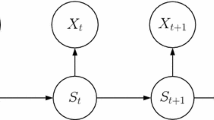Abstract
The present paper presents axiomatic characterizations for the final and sequential behaviours of Mealy and Moore automata. These abstract behaviours are described by isomorphic categories. Another model for them consists of the final and sequential behaviours of M-automata, a device which is introduced here as a new generalization of both Mealy and Moore automata. The category of M-automata decomposes into a category M ℓ isomorphic to the category of Mealy automata, and a category Mr whose objects can be viewed as being both Mealy and Moore automata. The category Mr is the pullback of the categories Mealy and Moore over the category S of semiautomata.
Similar content being viewed by others
References
Arbib M.A., Manes E.G.: Adjoint machines, state behavior machines and duality. J. Pure Appl. Algebra 6, 313–343 (1975)
Calude C., Calude E., Khoussainov B.: Deterministic automata: simulation, universality, and minimality. Ann. Pure Appl. Logic 90, 263–276 (1997)
Cavaliere M., Leupold P.: Evolution and observation—a non-standard way to generate formal languages. Theor. Comput. Sci. 321, 233–248 (2004)
Căzănescu V.E.: On the category of sequential automata (in Romanian). An. Univ. Bucureşti Mat. Inf. 16, 31–37 (1967)
Ciobanu G., Rudeanu S.: On the behaviour of automata. I. An. Univ. Bucureşti, Mat. Inf. 55, 119–128 (2006)
Ciobanu G., Rudeanu S.: Equivalent transformations of automata by using behavioural automata. J. Univers. Comput. Sci. 13, 1540–1549 (2007)
Creangă, I., Reischer, C., Simovici, D.: Algebraic Introduction in Computer Science (in Romanian). Automata Theory, Junimea, Iaşi (1973)
Ehrig H., Pfender M.: Kategorien und Automaten. W. De Gruyter, Berlin (1972)
Eilenberg S.: Automata. Languages and Machines, vol. A. Academic Press, London (1974)
Goguen J.A.: Realization is universal. Math. Syst. Theory 6, 359–374 (1973)
Goguen, J.A., Thatcher, J.W., Wagner, E.G., Wright, J.B.: A junction between computer science and category theory: basic concepts and examples, Part 1, IBM Report RC-4526 (1973); Part 2, IBM Report RC-5908 (1976)
Rudeanu S.: Behaviouristic automata. I. Minimal automata. An. Univ. Bucureşti Mat. Inf. 38, 64–71 (1989)
Rudeanu S.: Behaviouristic automata. II. The synthesis problem. An. Şti. Univ. A.I.Cuza Iaşi 35, 303–312 (1989)
Rudeanu S.: On the behaviour of semiautomata. In: Calude, C.S., Păun, Gh. (eds) Finite Versus Infinite, pp. 247–256. DMTCS/Springer, Heidelberg (2000)
Author information
Authors and Affiliations
Corresponding author
Rights and permissions
About this article
Cite this article
Ciobanu, G., Rudeanu, S. Final and sequential behaviours of M-automata. Acta Informatica 46, 361–374 (2009). https://doi.org/10.1007/s00236-009-0098-3
Received:
Accepted:
Published:
Issue Date:
DOI: https://doi.org/10.1007/s00236-009-0098-3




